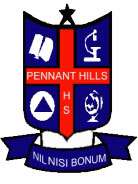Pennant Hills High School
| Pennant Hills High School | |
|---|---|
|
Nothing but the best | |
| Location | |
|
Australia | |
| Coordinates | 33°44′0″S 151°3′38″E / 33.73333°S 151.06056°ECoordinates: 33°44′0″S 151°3′38″E / 33.73333°S 151.06056°E |
| Information | |
| Type | Public, Secondary, Co-educational, Day school |
| Established | 1966 |
| Principal | Ross Warren |
| Enrolment | ~1270 |
| Campus | Suburban |
| Colour(s) | Red, Blue and White |
| Website | pennanthil-h.schools.nsw.edu.au |
Pennant Hills High School is a public, comprehensive, co-educational, high school situated in the northern suburb of Pennant Hills in Sydney, New South Wales, Australia, about 15–20 minutes to walk from Pennant Hills railway station. Established in 1966, the school had a student population of 1,270 students as of 2004, and has generally maintained these student numbers. The street address is Boundary Road, but all vehicular access is via Laurence Street.
Educational structure
Pennant Hills High School offers many subjects, with the faculties including Social Sciences, Science, Agriculture, English, Music, Christian Education, History, Maths, Visual Arts, Industrial Arts or TAS, Languages and Physical Education. PHHS also contains a Special Education system, helping physically and intellectually challenged students.
Prefects
Pennant Hills High School has a prefects program for students in Year 11 and 12. The prefects offer community service through hosting a variety of events and help teachers with uniform duties as well as an array of other tasks. The prefects also represent the school at public functions such as graduation ceremonies for the year 12 students at the end of the year.
Physical buildings and grounds
Pennant Hills High School contains a multi-purpose centre (Robert Stacey Hall), new Design and Technology/Visual Arts buildings, the Alfred Gray Memorial Library, and many specialty rooms including science labs, cooking and computer rooms. It also has two fields for sports such as football, rugby and cricket. An agricultural plot is located at the rear of the school, housing crops, sheep, chickens and other livestock.
The school's buildings were constructed according to the hilly terrain of the area, so that there are no more than two levels at any single point. PHHS has 4 levels, and room numbers are determined by which level it is in: Level 1 is primarily Social Sciences (Business Studies, Geography etc.), but also has Portable Rooms, which were used while the school was recovering from the fire, in 2001. Level 2 has Language, Agriculture, Science, Cooking, and Drama, while Level 3 (located at the Laurence Street level) is where the main quad of the school is located, along with the library and reception. It too, has Science rooms, as well as math, history, and Wood/Metal/Plastic Technology Rooms. Level 4 is primarily English, History, Maths and Visual Arts classrooms. The Industrial and Visual Arts building (completed in 2005) has two main entry points, from the Main Quad (in Level 3) and through a pedestrian bridge on Level 4.
The school suffered from a fire on 11 June 2001, destroying the school administration building, Industrial Arts Block, and the English, History, Mathematics and Visual Arts staffrooms.[1]
As is commonly the case with such school fires, many student works (notably Visual and Industrial arts HSC projects) were destroyed, causing considerable distress among affected students. Also as a result of this fire, many portable classrooms were set up for a number of years, near the main oval and where the COLA (Covered Outdoor Learning Area) is now situated. It is estimated that for at least 3 years there could have been up to 20-25 portables (this has not been confirmed). What we do know is that in 2005, the number of portables decreased, down to eight. In 2006, after the completion of the COLA and the new TAS/VA block, four of these were removed. Now (as of April 2009) these four remain. Three of these are used by English mainly. The other one is used for Special Education, as it has wheelchair access. Operation Phoenix Rising oversaw the completion of the rebuilding effort to be completed in 2012.
The school now has had an elevator installed between levels 2 and 4 (for use by disabled or injured students), and a new Design and Technology and Visual Arts building. In 2005, a new Covered Outdoor Learning Area (COLA) was constructed.
The Agriculture area is fondly known as the "Ag Plot" or the "Farm" and consists of several small paddocks, an area for growing plants, a machinery shed, a tool shed, a greenhouse and another shed that stores seeds and the like.
Sporting
Pennant Hills High School has a rich tradition of sporting culture. The school has enjoyed 18 years consecutive years of being crowned Champion School at Zone Cross Country and 17 consecutive years of being crowned Champion School in Zone Athletics. There are four sporting houses within the school, named Greenway, Yarrara, Bellamy and Redgum as the streets around the school.
Notable alumni
- Adam Rutter - Australian representative at the 2012 Olympics in Athletics[2]
- Dr William Rawlinson (class of 1976) - Awarded Member of the Order of Australia 2011.
- Verity James
- Dr Ken Wishaw[3]
- Anthony Ricketts
- Lisa Ho
- Senator John Faulkner.[4]
See also
References
- ↑ Tink, Andrew. "Pennant Hills High School Fire". Mr TINK (Epping) [5.21 p.m.]: In the early morning of Monday 11 June Pennant Hills High School was devastated by a major fire which destroyed approximately one-third of the school and caused millions of dollars worth of damage. NSW Government. Retrieved 10 March 2013.
- ↑ "London 2012 - Adam Rutter Athlete Profile". Retrieved 4 August 2012.
- ↑ Davis, Jason (8 February 2004). "The Man Who Saw Too Much". Sun Herald. Retrieved 9 March 2013.
- ↑ "Famous ex students of Pennant Hills High School". School Choice. Retrieved 9 March 2013.
